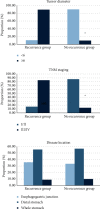Computed Tomography Texture Features and Risk Factor Analysis of Postoperative Recurrence of Patients with Advanced Gastric Cancer after Radical Treatment under Artificial Intelligence Algorithm
- PMID: 35655504
- PMCID: PMC9155975
- DOI: 10.1155/2022/1852718
Computed Tomography Texture Features and Risk Factor Analysis of Postoperative Recurrence of Patients with Advanced Gastric Cancer after Radical Treatment under Artificial Intelligence Algorithm
Abstract
Computer tomography texture analysis (CTTA) based on the V-Net convolutional neural network (CNN) algorithm was used to analyze the recurrence of advanced gastric cancer after radical treatment. Meanwhile, the clinical characteristics of patients were analyzed to explore the recurrence factors. 86 patients who underwent the advanced radical gastrectomy for gastric cancer were retrospectively selected as the research objects. Patients were divided into the no-recurrence group (30 cases) and the recurrence group (56 cases) according to whether there was recurrence after radical treatment. CTTA was performed before and after surgery in both groups to analyze the risk factors for recurrence. The results showed that the dice coefficient (0.9209) and the intersection over union (IOU) value (0.8392) of the V-CNN segmentation effect were signally higher than those of CNN, V-Net, and context encoder network (CE-Net) (P < 0.05). The mean value of arterial phase and portal phase (65.29 ± 9.23)/(79.89 ± 10.83), kurtosis (3.22)/(3.13), entropy (9.99 ± 0.53)/(9.97 ± 0.83), and correlation (4.12 × 10-5/4.21 × 10-5) of the recurrence group was higher than the no-recurrence group, while the skewness (0.01)/(-0.06) of the recurrence group was lower than that of the no-recurrence group (P < 0.05). Patients aged 60 years old and above, with a tumor diameter of 6 cm and above, and in the stage III/IV in the recurrence group were higher than those in the no-recurrence group, and patients with chemotherapy were lower (P < 0.05). To sum up, age, tumor diameter, whether chemotherapy should be performed, and tumor staging were all the risk factors of postoperative recurrence among patients with gastric cancer. Besides, CT texture parameter could be used to predict and analyze the postoperative recurrence of gastric cancer with good clinical application values.
Copyright © 2022 Zhiwu Zhou et al.
Conflict of interest statement
The authors declare no conflicts of interest.
Figures






Similar articles
-
[Establishment of artificial neural network model for predicting lymph node metastasis in patients with stage Ⅱ-Ⅲ gastric cancer].Zhonghua Wei Chang Wai Ke Za Zhi. 2022 Apr 25;25(4):327-335. doi: 10.3760/cma.j.cn441530-20220105-00010. Zhonghua Wei Chang Wai Ke Za Zhi. 2022. PMID: 35461201 Clinical Trial. Chinese.
-
Preoperative CT texture analysis of gastric cancer: correlations with postoperative TNM staging.Clin Radiol. 2018 Aug;73(8):756.e1-756.e9. doi: 10.1016/j.crad.2018.03.005. Epub 2018 Apr 4. Clin Radiol. 2018. PMID: 29625746
-
Tumor Heterogeneity in Human Epidermal Growth Factor Receptor 2 (HER2)-Positive Advanced Gastric Cancer Assessed by CT Texture Analysis: Association with Survival after Trastuzumab Treatment.PLoS One. 2016 Aug 12;11(8):e0161278. doi: 10.1371/journal.pone.0161278. eCollection 2016. PLoS One. 2016. PMID: 27517841 Free PMC article.
-
Adoption of Two-Dimensional Ultrasound Gastrointestinal Filling Contrast on Artificial Intelligence Algorithm in Clinical Diagnosis of Gastric Cancer.Comput Math Methods Med. 2022 Apr 30;2022:7385344. doi: 10.1155/2022/7385344. eCollection 2022. Comput Math Methods Med. 2022. PMID: 35535230 Free PMC article.
-
Could texture features from preoperative CT image be used for predicting occult peritoneal carcinomatosis in patients with advanced gastric cancer?PLoS One. 2018 Mar 29;13(3):e0194755. doi: 10.1371/journal.pone.0194755. eCollection 2018. PLoS One. 2018. PMID: 29596522 Free PMC article.
Cited by
-
Construction and Validation of a m7G-Related Gene-Based Prognostic Model for Gastric Cancer.Front Oncol. 2022 Jun 30;12:861412. doi: 10.3389/fonc.2022.861412. eCollection 2022. Front Oncol. 2022. PMID: 35847903 Free PMC article.
References
MeSH terms
LinkOut - more resources
Full Text Sources
Medical

